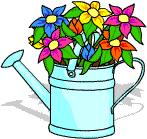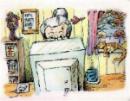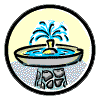Guide ML for Non-Geeks
Created | Updated Jun 10, 2005
Under construction!!! More will be added later.
Don't Panic!
It looks like it's got to be impossibly complicated for a non-geek, but it's not really all that bad. Just take one little thing at a time and update your page frequently so you don't run the risk of losing all your work. You don't need to complete everything you want to do in one session or learn everything before you start. In fact you don't really need to learn a thing about Guide ML - just learn to copy and paste!1 There is no easier way to create your own unique page.
So, if you're ready to take the plunge, read the first section below about getting started, and make those changes first. Then you can browse down through the headers and choose which changes you want to make to your page next.
Getting started
If you've already written an introduction on your page, click on "Edit page". That will bring up what you've already written on your page in a text box.
First thing with guide ml is to stick the tags
<GUIDE>
<BODY>
at the very top, before anything you want to show on your page. Then you need to stick in
</BODY>
</GUIDE>
at the very bottom of your page. Now, below the text box, tick where it says Guide ML and click change style. After that, when you click update introduction, your page will be in Guide ML style.
If you have not yet written anything in the way of an introduction, before you update it, you can simply tick the box that says "Guide ML", then click on "change style" and this step will already be done for you.
(Notice that at the bottom of the page, the tags will need to be in the opposite order from the top. This is the way you have to do all opening and closing tag sets so that the computer doesn't get confused - you have to end everything you tell it to do in the opposite order from how you began it or you'll get error messages when you try to update it.)
Now you have your page in Guide ML, but everything you have on there will be one big paragraph. So you'll want to stick in some
<BR/>
tags between each paragraph.
Use one of those for each time you want to go to a new line - if you put in two of those, you'll get a blank line between lines of typing on the resulting page so that it looks like you skipped a line, the way we normally do when we type a new paragraph.
Some researchers prefer the <BR/> tag as the easiest to use because you can control how many spaces there are between lines of text, paragraphs or pictures, depending on how many <BR/>s you put in.
Alternately, you could just use the
<P>
tag (opening the paragraph) at the beginning of each paragraph, and the
</P>
tag (closing the paragraph) at the end of each paragraph. To give you another way this can be done, you could also use this tag to separate paragraphs:
<P/>
If you use that one, you won't need to use one at the end of the paragraph, just the beginning.
(Notice the difference between the location of the "/" in the two tags... that's why you can get away with only using the one instead of needing both an opening and closing tag. The <BR/> tag works the same way. Simple way to tell if you need a second tag to make it work: If the "/" is before the directions, you'll need an opening tag also. If it's after the directions, you won't need an opening tag.)
Smileys
You're probably already used to using smileys of all types in your posts and you can hardly type anything on here without using them, so it's only natural that you'd want to use them on your page too.
Unfortunately, the way you've been doing them in conversation posts (<smiley>) won't work in Guide ML.

Luckily, they're still very easy to add to your page
 using the following pattern:
using the following pattern:<SMILEY TYPE="smiley"/>
Just substitute the word "smiley" with whatever smiley you had in mind, and you'll be able to
 and
and  , as well as serve up
, as well as serve up  , and
, and  on your page.
on your page.Need Smileys? Go to the Smiley Page to see all the codes.
Adding Pictures to your page
One thing that will make your page distinctive in a sea of Intro Pages is to add pictures. This is a lot easier to do than you might think. Just go to the h2g2 picture library or the Community-Art page and pick out a picture you like. You'll find links and codes for a wide variety of pictures you can use on your page. There are also some pictures available on the Blob Page.
So, let's say for instance that you decide you want the "Flowers in a watering can" picture from the H2G2 Picture Library on your page. Next to the picture of the flowers you will find what is called a "blob" code in it's own little text block. Copy the entire code in that block and paste it onto your page, wherever you want the picture to be located on your page. If you put it before any of the text you write, then it will be right at the top of the page. If you put it between paragraphs, it will show up between those paragraphs. Don't forget to put in the <BR/> code a couple of times before and after it if you want it completely separated from the text on your page, otherwise the text will be right against the picture.
The default position for the pictures is always in the center, but if you would rather have your picture on the left or right, that can be done very easily:
<PICTURE EMBED="CENTER" BLOB="B430479" ALT="Flowers in a watering can"/>
will put it in the center where it will look like:

To put it on the left, replace the word "CENTER" with "LEFT", likewise, to put it on the right side of your page, replace "CENTER" with "RIGHT". Don't forget to keep the quotation marks, and be sure everything else in the code remains exactly as it was originally - don't add in or lose any spaces in the code, or change anything else. That's the way you do it with all the picture library blobs and for the ones on the community art pages too.
Unfortunately, we aren't allowed to use personal photos or artwork on our pages. When you see that someone has an actual photo on their page, it's only because it has at some time been used as part of an article in
 or the rare edited entry that uses a photo, but that's the only way we are currently allowed to use personal photos on our pages.
or the rare edited entry that uses a photo, but that's the only way we are currently allowed to use personal photos on our pages.
If you want to do something a little more
 complicated looking, for instance like what you see here with just a line or two of text above the picture, and maybe a few lines lower, there's another picture on the opposite side, just put the blob code in the middle of a sentence and that's where your picture will show up. Sometimes it requires playing with exactly which word
complicated looking, for instance like what you see here with just a line or two of text above the picture, and maybe a few lines lower, there's another picture on the opposite side, just put the blob code in the middle of a sentence and that's where your picture will show up. Sometimes it requires playing with exactly which word you put the blob code after to get the lines to work out right. Just keep hitting update page after each try until you like the way it looks. You do the same thing if you want to put a picture on the opposite side a few lines lower, with text wrapped around it - keep re-positioning it until it makes the page look best. Of course, don't forget to replace the "CENTER" designation with "LEFT" or "RIGHT" in the code.
you put the blob code after to get the lines to work out right. Just keep hitting update page after each try until you like the way it looks. You do the same thing if you want to put a picture on the opposite side a few lines lower, with text wrapped around it - keep re-positioning it until it makes the page look best. Of course, don't forget to replace the "CENTER" designation with "LEFT" or "RIGHT" in the code.For the pictures above, the one of Agony Aunt at her computer would have the code:
<PICTURE EMBED="RIGHT" BLOB="B763264" ALT="Agony Aunt (small) by Wowbagger"/>
For the picture of the fountain, you would use the code:
<PICTURE EMBED="LEFT" BLOB="B820606" ALT="h2g2 waterworks fountain by Bluebottle"/>
Colors and Fonts
You can also change the colors of the text on your page by inserting codes for the colors of your choice found on the Web Safe Colors page.Anything between the codes will be in the color you have indicated in that particular code, as follows:
<FONT color="000000">This text will be in the color of your choice.</FONT>
Have fun with it!
You can also change the appearance of your text using the <I>Italics</I> and <B>Bold</B> tags.
You could also use those codes together, as well as in combination with the color tags above, as in:
Have fun with it!
Links
There will probably be entries on h2g2 or sites on the web to which you'd like to be able to go directly from your page. Perhaps you'd also like to be able to provide links for those who drop by your page.
Again, not as difficult as it might seem. The code below is what you would use to put in a link to the smiley page.
<LINK H2G2="A155909">Smiley Page</LINK>
Notice that the A number is in the first part of the link code, with the name of the page betweem the opening and closing tags. What you'll want to do is to replace that number with the number of the guide entry you want to link to, and then type in the name of the entry in place of where it says smiley page.
To put in a link to a specific conversation instead of the entry it's connected to, the link should follow this pattern: <LINK H2G2="F12345">Conversation Title</LINK> Don't forget to substitute the proper F# of the conversation, and the name of the conversation you're linking!
In the case of a link outside of h2g2, you will need to change the code as follows:
<LINK HREF="http//www.youraddresshere>Your site name here</LINK>
Obviously you'll want to substitute the address of the site you want to link to, and the name of that site in the appropriate places.
Don't forget that any outside sites referenced need to fall within the guidelines set up in the House Rules, or you could just end up having your page moderated, and after you've put all this work into it, you don't want that happening.
Fun Features
There are many little features that you can add to your Guide ML code for convenience or to personalize it even further.
The Viewer Tag
On some pages, you will think that somehow the writer knew you were going to visit the page. Sometimes it's done in a friendly way:
Hi, ! Welcome to my page!
Sometimes it's done for fun and freak-out value:
I have proof that is a threat to national security, and have notified the authorities.
Very simple code for this one: Simply insert the tag
<VIEWER/>
in the appropriate place on your page, within a sentence greeting your viewer.
Who has you on their friends list?
When you click on the "add to friends" button on someone's page, their name will be listed at the end of your page. If you would like to see who has you on their list, add the
<OPTIONS WATCHING-USERS="1"/>
tag to the end of your page, between the </GUIDE> and </BODY> tags.
Pop-up Conversations Window
This one gives you the first 20 conversations on your list in a little pop-up window, with links to additional groups of 20 conversations. 2 Just copy the following code onto your page in a convenient place.
<POPUPCONVERSATIONS>Your conversations</POPUPCONVERSATIONS>
Of course, you may change the words between the opening and closing tags to suit your personality. Some people prefer the obvious "your conversations" or "start your day here", others something a bit more unique like "Don't click here!"
Thread Intros
You may have noticed as you were posting to a conversation a little personalized message above the text window. That's called a Thread Intro, and comes in two different varieties, one for when someone is starting a new thread on your page, and one for threads that have already been established. The two codes are as follows:
<FORUMTHREADINTRO>Your message to those posting to your page goes here </FORUMTHREADINTRO>
<ADDTHREADINTRO>Your message to those posting on one of the threads on your page goes here.</ADDTHREADINTRO>
You will want to add these codes at the top of your page, under the <GUIDE> and
<BODY> tags.
In addition to adding a simple message, you could insert the <VIEWER> tag to greet those posting on your page, or add smileys.
Choosing your own colors in the Brunel skin
Another way that you can personalize your page is to change the colors for your page in the Brunel skin 3 If you're new to H2G2, this is the default skin, the one you're probably using right now, unless you have chosen to change to the classic (goo blue) skin, or the alabaster skin.
This is another code that you will need to put at the top of your page, under the <GUIDE> and
<BODY> tags. The codes for changing your Brunel colors are as follows:
<BRUNEL>
<LITE>#000000</LITE>
<NORM>#000000</NORM>
<DARK>#000000</DARK>
<WORD>blue</WORD>
</BRUNEL>
You will need to replace the 000000's in the code with the colors of your choice from Web Safe Colors guide entry.4
I want that on my page!
This entry can't possibly cover every single feature you might see in an entry or on another researcher's page that you'd love to have on your page. Before you start this, make a mental note of the text or pictures surrounding the feature you want on your page.
It's easy find the code by bringing up the diagnostics of the page:
Where a researcher's page has the "U" in the address, substitute the words "testuserpage" (without quotation marks, and without any spaces). Be sure to leave the rest of the address exactly as it is. Then hit "enter" on your keyboard, and the code for the entire page will be shown.
On a guide entry, replace the "A" with the word "test", again without the quotation marks, and without changing anything else in the address or adding any spaces. Then hit "enter" on the keyboard to see the code for the page.
After having worked with Guide ML on your own page, you should be familiar with a lot of the codes you will see. Look for the text or pictures surrounding the feature you're interested in, and look for the code tags (which you should know by now are enclosed in the <>s) It shouldn't be too difficult to pinpoint exactly where the code is for the feature you want.
Next, you just copy and paste the entire code to your page, being sure you copy both the opening and closing tags.
Depending on what it is that you copy, you may be able to make some modifications in the feature when you add it to your page. For instance, if what you wanted was a particular background but you wanted to change the text color, font or words, often you will be able to do that5.
